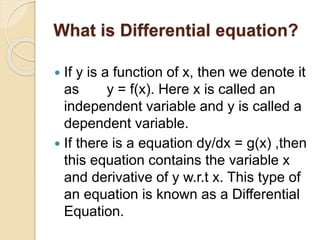
Differential equations of first order
- 1. What is Differential equation? If y is a function of x, then we denote it as y = f(x). Here x is called an independent variable and y is called a dependent variable. If there is a equation dy/dx = g(x) ,then this equation contains the variable x and derivative of y w.r.t x. This type of an equation is known as a Differential Equation.
- 2. Order of Differential Equation Order of the highest order derivative of the dependent variable with respect to the independent variable occurring in a given differential equation is called the order of differential equation. E.g. – 1st order equation 2nd order equation
- 3. Degree of Differential Equation When a differential equation is in a polynomial form in derivatives, the highest power of the highest order derivative occuring in the differential equation is called the degree of the differential equation. E.g. – Degree – 1 ,(d²y/dx) + dy/dx = 0 Degree – 2 , (d²y/dx)² + dy/dx = 0
- 4. Solution of differential equations of the first order and first degree Differential equations of 1st order can be solved by many methods ,some of the methods are as follows :- 1. Variable Separable Method 2. Exact equation method 3. Homogenous equation method 4. Linear equation method
- 5. Solution of differential equations of the first order and first degree 5. Non-Linear Equation method (Bernoulli's equation) 6. Non-Exact Equation method
- 6. ( , )y f x y
- 7. Important Forms of the method Here are some important forms of the method through which we can know the form of equation and then use or apply the method which is required :- 1. Variable Separable method – Equation is in the form of : dy/dx = M(x)/N(y) or dy/dx = M(x)N(y)
- 8. Important Forms of the method 2. Exact equation method – equation is in the form of : Mdx + Ndy = 0 --- 1 If , ∂M/∂y = ∂N/∂x Then the above equation 1 is Exact equation 3. Homogenous equation method - equation is in the form of : dy/dx = x²y + x³y + xy²/x³ - y³ (Example)
- 9. Important Forms of the method 4. Linear equation method - equation is in the form of : Form -1 : dy/dx + Py = Q (x form) Form - 2 : dx/dy + Px = Q (y form) 5. Non-Linear Equation method (Bernoulli's equation) - equation is in the form of : Dy/dx – 2ytanx = y²tan²x (Example)
- 10. Important Forms of the method 6. Non-Exact Equation method - equation is in the form of : Type – 1 : Mdx + Ndy = 0 F(x) = 1/N (∂M/∂y - ∂N/∂x) (x form) Type – 2 : Mdx + Ndy = 0 F(y) = 1/M (∂N/∂x - ∂M/∂y)
- 11. 1st Order DE - Homogeneous Equations Homogeneous Function f (x,y) is called homogenous of degree n if : y,xfy,xf n Examples: yxxy,xf 34 homogeneous of degree 4 yxfyxx yxxyxf , , 4344 34 yxxyxf cossin, 2 non-homogeneous yxf yxx yxxyxf n , cossin cossin, 22 2
- 12. 1st Order DE - Homogeneous Equations The differential equation M(x,y)dx + N(x,y)dy = 0 is homogeneous if M(x,y) and N(x,y) are homogeneous and of the same degree Solution : 1. Use the transformation to : dvxdxvdyvxy 2. The equation become separable equation: 0,, dvvxQdxvxP 3. Use solution method for separable equation Cdv vg vg dx xf xf 1 2 2 1 4. After integrating, v is replaced by y/x
- 13. Variable – separable example 1. dy/dx = x.y =dy/y = xdx =∫dy/y = ∫xdx =logy = x²/2 + c
- 14. Exact Equation Example 1. xdy/dx + y + 1 = 0 =xdy + (y + 1)dx = 0 here , M = y + 1 , N = x ∂M/∂y = 1 , ∂N/∂x = 1 therefore , ∂M/∂y = ∂N/∂x here the given equation is an exact equation ∫Mdx(y constant) + ∫(terms of N not containing x)dy = c
- 15. Exact Equation Example =∫(y + 1)dx (y constant) + ∫0.dx = c = x(y + 1) = c
